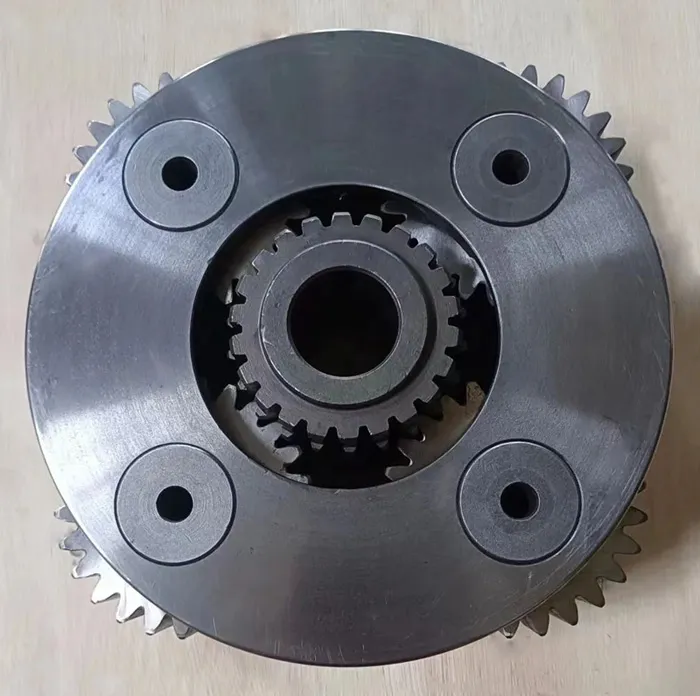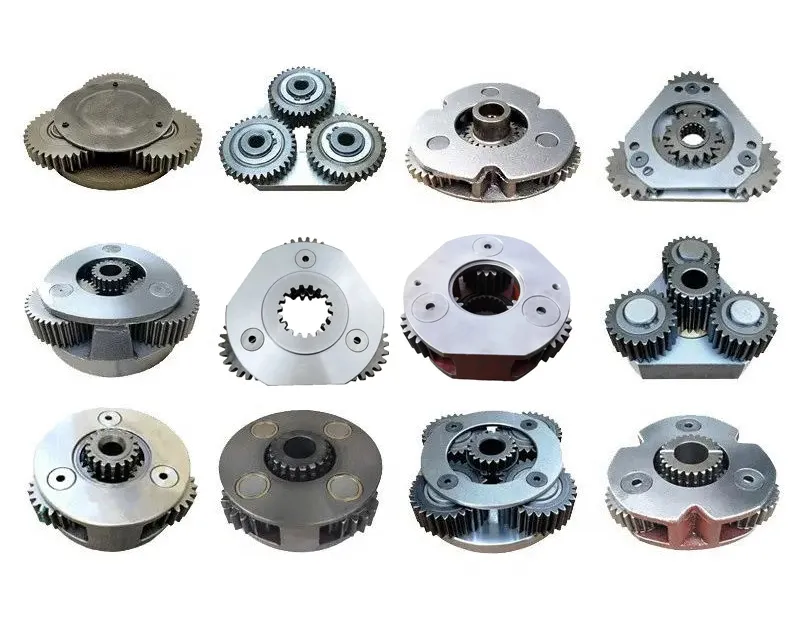
Excavators are remarkable pieces of machinery that play an essential role in construction, mining, and various other heavy-duty operations. One of the critical components that contribute to their efficient functioning is the gear system, specifically the planetary gears and sun gears. In this blog, we will delve deep into the intricacies of these gears, their roles, their advantages, and the potential issues that may arise. By the end of this comprehensive analysis, you will have a clear understanding of what planetary gears and sun gears are and why they are so vital to the operation of excavators.
Planetary gears, as the name suggests, are a system of gears that work together in a configuration that mimics the solar system. The system consists of three main components: the sun gear, the planet gears, and the ring gear. The sun gear is positioned at the center, the planet gears surround the sun gear, and the ring gear encircles the planet gears. This configuration allows for high torque transmission in a compact space, making it ideal for applications like excavators.
1. Sun Gear:
The sun gear is the central gear around which the planet gears revolve. It is typically the input gear that receives power from the motor or engine. The sun gear plays a crucial role in determining the speed and torque of the output.
2. Planet Gears:
The planet gears are smaller gears that orbit around the sun gear. They are usually mounted on a movable carrier, which can either spin freely or be fixed in place. The planet gears engage with both the sun gear and the ring gear, allowing for the distribution of load and torque.
3. Ring Gear:
The ring gear is an outer gear that surrounds the planet gears. It is usually stationary or fixed to the housing of the gearbox. The ring gear engages with the planet gears, providing an outer boundary for the planetary gear system.
The working principle of planetary gears is based on the interaction between the sun gear, planet gears, and ring gear. When the sun gear rotates, it drives the planet gears, which in turn rotate around the sun gear. The planet gears also mesh with the ring gear, causing the ring gear to either rotate or remain stationary, depending on the design of the gearbox.
The unique configuration of planetary gears allows for multiple gear ratios, depending on which component is held stationary and which is used as the input or output. This flexibility in gear ratios makes planetary gear systems highly efficient and versatile for various applications.
Planetary gears offer several advantages that make them ideal for use in excavators:
1. High Torque Transmission:
Planetary gears can transmit high torque in a compact space, making them suitable for heavy-duty applications like excavators. The distribution of load among multiple planet gears reduces the stress on individual gears, enhancing the overall durability of the system.
2. Compact Design:
The coaxial arrangement of sun, planet, and ring gears allows for a compact design, saving valuable space within the excavator. This compactness also reduces the overall weight of the machinery, improving its efficiency.
3. Multiple Gear Ratios:
Planetary gear systems offer multiple gear ratios, providing flexibility in speed and torque output. This versatility allows excavators to operate efficiently in various conditions, from delicate tasks to heavy lifting.
4. High Efficiency:
The engagement of multiple gears reduces the loss of power due to friction, resulting in high efficiency. Planetary gears can achieve efficiency levels of up to 97%, making them highly effective for energy transmission.
5. Load Distribution:
The distribution of load among multiple planet gears reduces the wear and tear on individual gears, extending the lifespan of the gear system. This load distribution also enhances the smoothness of operation, minimizing vibrations and noise.
The sun gear is a central component of the planetary gear system and plays a crucial role in the operation of excavators. It is typically the input gear that receives power from the motor or engine and transmits it to the planet gears.
1. Material and Construction:
Sun gears are usually made from high-strength materials like hardened steel to withstand the high torque and stress they encounter. The construction of sun gears involves precise machining to ensure accurate meshing with the planet gears, minimizing friction and wear.
2. Role in Gear Ratios:
The size and number of teeth on the sun gear play a significant role in determining the gear ratios of the planetary gear system. By changing the size of the sun gear, manufacturers can achieve different speed and torque outputs, providing flexibility in the design of excavators.
3. Maintenance and Wear:
Regular maintenance of the sun gear is essential to ensure the smooth operation of the planetary gear system. Wear and tear on the sun gear can lead to increased friction, reduced efficiency, and potential failure of the gear system. Regular inspection and lubrication are crucial to prolonging the lifespan of the sun gear.

While planetary and sun gears offer numerous advantages, they are not immune to issues. Some common problems associated with these gears include:
1. Gear Wear and Tear:
Continuous operation under high torque can lead to wear and tear on the gears. This wear can result in increased friction, reduced efficiency, and eventual failure of the gear system. Regular maintenance and timely replacement of worn gears are essential to prevent such issues.
2. Lubrication Issues:
Proper lubrication is crucial for the smooth operation of planetary gears. Inadequate lubrication can lead to increased friction and heat, causing premature wear and potential failure of the gears. Regular inspection and maintenance of the lubrication system are essential to ensure optimal performance.
3. Misalignment:
Misalignment of gears can result in uneven load distribution and increased wear. This misalignment can be caused by manufacturing defects, improper assembly, or wear on the gear components. Regular inspection and alignment checks are necessary to prevent such issues.
4. Material Defects:
Material defects in the gears can lead to premature failure. These defects can be caused by manufacturing errors or poor-quality materials. Ensuring the use of high-quality materials and rigorous quality control during manufacturing can help mitigate this issue.
5. Overloading:
Exceeding the designed load capacity of the gear system can lead to excessive stress and potential failure. It is essential to operate the excavator within its specified load limits to prevent overloading and prolong the lifespan of the gear system.
Planetary gears and sun gears are integral components of excavators, playing a crucial role in their efficient operation. The unique configuration of planetary gears allows for high torque transmission, compact design, multiple gear ratios, high efficiency, and load distribution. Sun gears, as the central component of the planetary gear system, play a vital role in determining the gear ratios and transmitting power.
While planetary and sun gears offer numerous advantages, they are not without potential issues. Regular maintenance, proper lubrication, alignment checks, and the use of high-quality materials are essential to ensure the smooth operation and longevity of the gear system.
Understanding the intricacies of planetary and sun gears in excavators provides valuable insights into their importance and the need for proper maintenance. By paying attention to these critical components, we can ensure the efficient and reliable operation of excavators, contributing to the success of various heavy-duty operations.
I hope this comprehensive analysis has provided you with a clear understanding of planetary gears and sun gears in excavators. If you have any further questions or need more information, feel free to reach out.